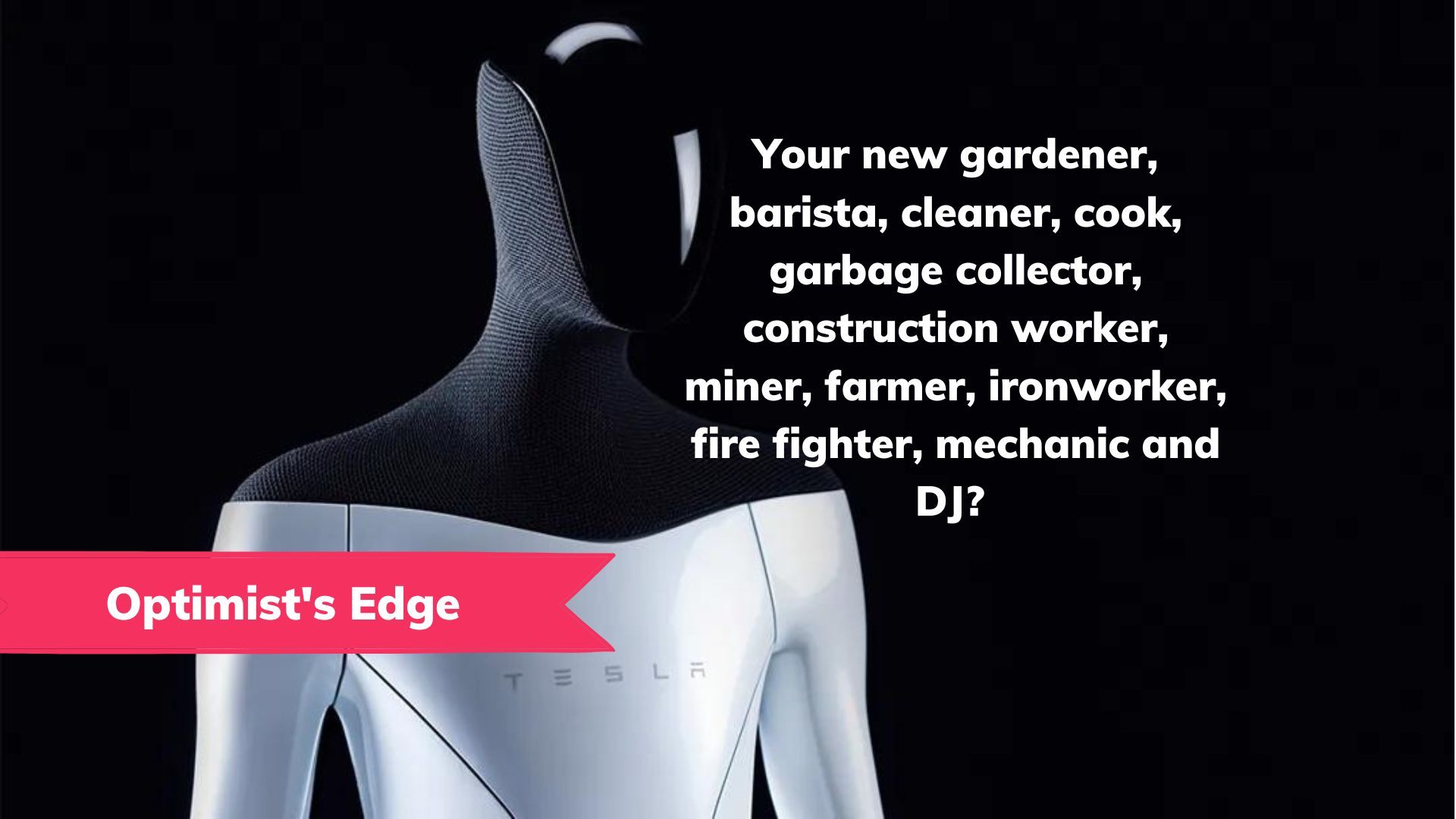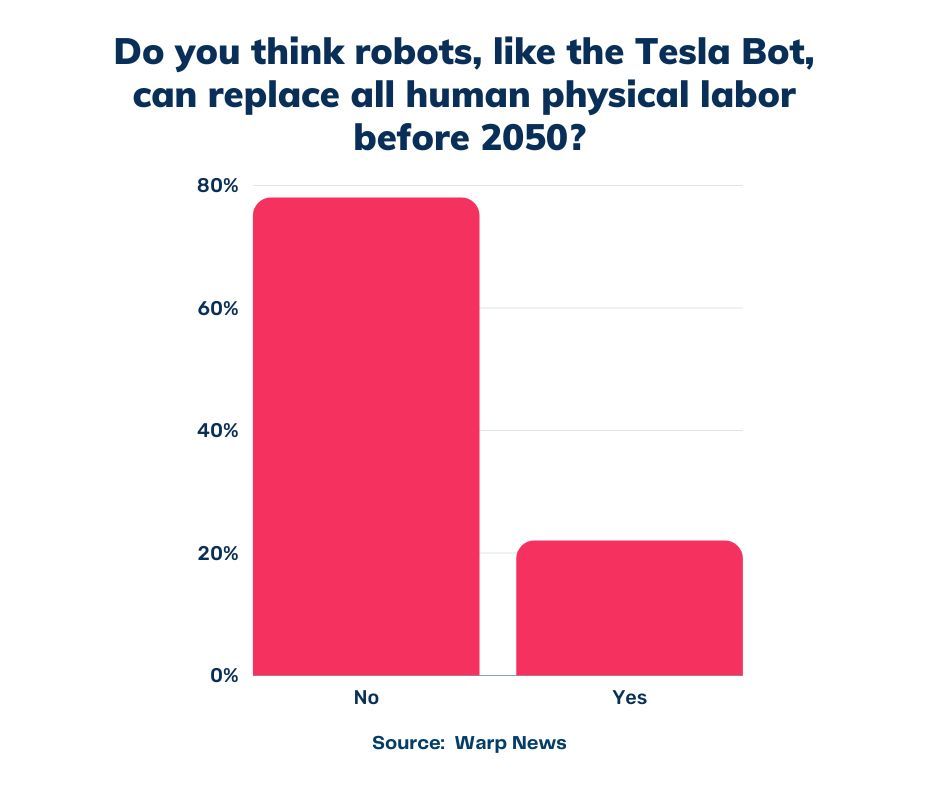
💡 Optimist’s Edge: Will the Tesla Bot replace all physical human labor?
Robots that understand and can interact with the surrounding environment will be able to replace all physical human labor, which will lead to a dramatic expansion of the world economy.
Share this story!
📉 What people think
In our survey, we asked if people believe robots, like the Tesla Bot, can replace all human physical labor before the year 2050? 78 percent don’t think that is possible, while 22 percent think it is.

📈 Here are the facts
There are millions of robots working in manufacturing, vacuuming our homes or mowing our lawns. They work day and night and never get tired, but might have to recharge their batteries sometimes. Our robots are good at repetitive work, but not very skilled at handling a multitude of tasks in varying environments. Your Roomba can’t cut the grass.
That might change soon.
Solving vision
On our roads, there is an increasing number of robots driving around. Usually, we call them cars, but these cars drive themselves. At least they try to. They still need human supervision but are getting better all the time.
Tesla has come the furthest, with about 200,000 cars involved in their beta test for Full-Self Driving. They have chosen a path that will make it possible to not just make autonomous cars, but also other robots ‘self-driving’. Tesla’s approach is based purely on vision. The car uses eight cameras to see the world around it and advanced artificial intelligence helps understand and interact with it.
When Tesla, or someone else, solves this problem and the car truly understands the environment it is operating in, that skill can then be transferred to other types of robots.
That is why last year on AI Day they launched the Tesla Bot, named Optimus Prime.
“Essentially, to have the humanoid part, we need to develop some custom actuators and sensors – and essentially use the Tesla Full Self-Driving and Autopilot or generally speaking real-world navigation AI in the humanoid robot.”
– Elon Musk
Self-driving is a very hard problem to solve and we can’t be certain when it will be done, but there are a couple of good arguments for why it will happen in the next few years. The effort is partly based on machine learning and for that, you need lots of data to train the AI. All Tesla cars are gathering data when they are in use, and the beta test for Full-Self Driving has already reached 200,000 cars. At the same time, Tesla is building a huge AI capacity and training computers, and hiring the best AI people in the world.
When self-driving cars are solved, you have to transfer the skills from understanding roads to understanding all kinds of environments. This will take time, but we are heading that way now and the path forward seems pretty clear.
Not only vision and sensors
More than vision has to be solved to get the robots to be able to do a variety of things. Like humanlike hands, or something other to grip with. Answers with Joe give a good run-through of what else is needed (even though I think his conclusions are too pessimistic.)
💡 Optimist's Edge
Imagine an almost limitless supply of cheap robot workers. We can do much more, better and cheaper. Take care of humans, plants, animals, and the entire planet better. The same robot can mow the lawn, clean the house, do the dishes, wash the clothes and make a great cappuccino for you.
The foundation of the economy is labor. If a huge chunk of that is super cheap and almost limitless the economy will expand like nothing we’ve seen before.
Millions of people that now work for low wages in boring, dangerous, menial jobs will be set free to do something else.
But won't they become unemployed? No. First, there is a huge labor shortage. The latest prognosis points to a shortage of 85 million workers by 2030. Second, they will have new, better jobs. Or might not even have to work, if they don’t want to, and instead find other meaningful things to occupy them. Physical labor could become a choice.
What if you, in the year 1700 when 99 percent of people were farmers, would have said that we were about to invent this thing called a tractor that will take away the job of 98 percent of farmers. People would have been shocked and it would have been impossible to imagine what they would do instead of being farmers.
We don’t know what everyone will do, but we know that our creativity will come up with tons of ideas.
👇 How to get the Optimist's Edge
❓ So, how do you get the most out of this knowledge?
- Study machine learning at university. There are many courses to choose from all over the world. 10 Best Machine Learning Courses to Take in 2022.
- Take Andrew Ng’s free online Stanford course in machine learning.
- Billions of sensors are going to be needed. Here are the seven largest sensor manufacturers in the world. Or start your own sensor business.
- Get a job at Tesla AI.
- Get a job at Boston Dynamics.
- Form a team of young people (4-18 years old) and compete in FIRST Robot competition.
- Watch Tesla AI Day. It gives great insight into the cutting-edge technology and ambitions of one of the world's leading real-world AI companies.
You now have an advantage because you have gained this knowledge before most others –